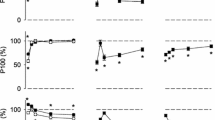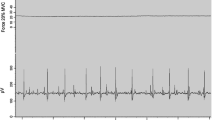Summary
Recording of the force-time (f-t) characteristics of muscular contraction expresses the rate at which tension is developed. To further understand the problems involved in force production during voluntary contraction, the f-t curve was registered during maximal voluntary isometric extension of both legs performed in the sitting position with the knee angle at 107 degrees. 38 athletes representing various sport events, five pairs of monozygous, and ten pairs of dizygous twins were used as subjects. The reference group consisted of eight normal men. The data disclosed that the time to produce certain force levels showed good trial-to-trial and satisfactory day-to-day reproducibility below tension levels of 0.9×P 0. At these force levels the time of tension development was positively (p<0.05) related to the per cent distribution of slow twitch fibers in the vastus lateralis muscle. This result is consistent with animal experiments concerning the mechanical characteristics of slow and fast muscles. In addition, it was observed that the athletic groups had f-t curves different from the other subjects. Genetic factors had only slight influence on the f-t measurement.
Similar content being viewed by others
References
Barany, M.: ATPase activity of myosin correlated with speed of muscle shortening. J. Gen. Physiol. 50, 197–218 (1967)
Bergemann, B. W.: Effects of practice and pretension on the rate of tension development in muscle. Ph.D. Thesis. The Pennsylvania State University, USA 1977
Bergström, J.: Muscle electrolytes in man. Scand. J. Clin. Lab. Invest. (Suppl.) 68 (1962)
Brody, I. A.: Regulation of isometric contraction in skeletal muscle. Exp. Neurol. 50, 673–683 (1976)
Burke, R. E., Levine, D. N., Zajac, F. E., Tsairis, P., Engel, W. K.: Mammalian motor units. Physiological-histochemical correlation in three types in cat gastrocnemius. Science 174, 709–712 (1971)
Close, R.: Dynamic properties of fast and slow skeletal muscles of the rate during development. J. Physiol. 173, 74–95 (1964)
Gollnick, P. D., Armstrong, R. B., Saubert IV, C. W., Piehl, K., Saltin, B.: Enzyme activity and fiber composition in skeletal muscle of untrained and trained men. J. Appl. Physiol. 33, 312–319 (1972)
Gydikov, A., Dimitrov, G., Kosarov, D., Dimitrova, N.: Functional differentiation of motor units in human opponens pollicis muscle. Exp. Neurol. 50, 36–47 (1976)
Harigaya, S., Schwartz, A.: Rate of calcium binding and uptake in normal animal and failing human cardiac muscle. Circ. Res. 25, 781–794 (1969)
Komi, P. V.: A new electromechanical ergometer. In: 3. Internationales Seminar für Ergometrie, pp. 173–176. Berlin: Ergon 1973
Komi, P. V., Rusko, H., Vos, J., Vihko, V.: Anaerobic performance capacity in athletes. Acta Physiol. Scand. 100, 107–114 (1977a)
Komi, P. V., Viitasalo, J. T., Havu, M., Thorstensson, A., Sjödin, B., Karlsson, J.: Skeletal muscle fibers and muscle enzyme activities in monozygous and dizygous twins of both sexes. Acta Physiol. Scand. 100, 385–392 (1977b)
Padykula, H. A., Herman, E.: The specificity of the histochemical method of adenosine triphosphatase. J. Histochem. Cytochem. 3, 170–195 (1955)
Ralson, H. J., Polissar, M. J., Inman, V. T., Close, J. R., Feinstein, B.: Dynamic features of human isolated voluntary muscle in isometric and free contractions. J. Appl. Physiol. 1, 526–533 (1949)
Royce, J.: Force-time characteristics of the exertion and release of hand grip strength under normal and fatigued conditions. Res. Q. Am. Assoc. Health Phys. Educ. 33, 444–450 (1962)
Rusko, H., Havu, M., Karvinen, E.: Aerobic performance capacity in athletes. Eur. J. Appl. Physiol. 38, 151–159 (1978)
Steg, G.: Efferent muscle innervation and rigidity. Acta Physiol. Scand. (Suppl.) 61 (1964)
Thorstensson, A.: Muscle strength, fibre types and enzyme activities in man. Acta Physiol. Scand. (Suppl.) 443 (1976)
Thorstensson, A., Hultén, B., von Döbeln, W., Karlsson, J.: Effect of strength training on enzyme activities and fibre characteristics in human skeletal muscle. Acta Physiol. Scand. 96, 392–398 (1976a)
Thorstensson, A., Grimby, G., Karlsson, J.: Force-velocity relations and fiber composition in human knee extensor muscles. J. Appl. Physiol. 40, 12–16 (1976b)
Thorstensson, A., Karlsson, J., Viitasalo, J. H. T., Luhtanen, P., Komi, P. V.: Effect of strength training on EMG of human skeletal muscle. Acta Physiol. Scand. 98, 232–236 (1976c)
Viitasalo, J. T., Komi, P. V.: Force-time characteristics of human skeletal muscle; effect of fiber composition, fatigue and training. In: The International Congress of Physical Activity Sciences, Quebec City, Canada, 11–15 July, 1976
Author information
Authors and Affiliations
Rights and permissions
About this article
Cite this article
Viitasalo, J.T., Komi, P.V. Force-time characteristics and fiber composition in human leg extensor muscles. Europ. J. Appl. Physiol. 40, 7–15 (1978). https://doi.org/10.1007/BF00420984
Accepted:
Issue Date:
DOI: https://doi.org/10.1007/BF00420984




